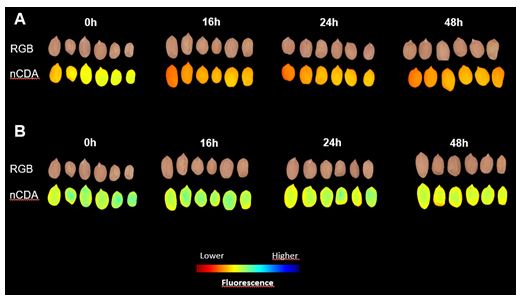Chlorophyll fluorescence as a new marker for peanut seed quality evaluation
DOI:
https://doi.org/10.52755/sas.v2iedesp1.111Palavras-chave:
seed vigor, image analysis, non-destructive methodsResumo
Recent advances in optical imaging technologies have contributed to rapid, accurate and non-destructive analysis in the context of seed quality. This work aimed to verify the potential of chlorophyll fluorescence images as a new marker for analyzing the physiological potential of peanut seeds. The fluorescence signals of chlorophyll a and b were detected in the excitation/emission combinations of 630/700 nm and 405/600 nm, respectively, using seeds artificially aged for 0, 16, 24 and 48 h. The images were captured using a VideometerLab4 equipment (Videometer A/S, Herlev, Denmark), and its software version 5.4.6. Data were compared with the traditional tests used to evaluate the physiological performance of peanut seeds, such as germination tests, electrical conductivity, seedling emergence and emergence speed index. The results revealed that the fluorescence intensity of chlorophyll a and b was lower in seeds with lower vigor. Therefore, the deterioration process of peanut seeds is accompanied by a breakdown of chlorophyll molecules, and consequently, changes in the fluorescent properties of seeds. From a practical point of view, chlorophyll fluorescence images can be successfully used to discriminate high-and low-vigor seed lots, quickly, accurately and non-destructively.
Downloads

Downloads
Publicado
Como Citar
Edição
Seção
Licença
Copyright (c) 2021 Julia Marconato Sudki, Anna Clara ´Parisi Absalonsen Kimura da Silva, Valter Arthur, Clíssia Barboza da Silva

Este trabalho está licenciado sob uma licença Creative Commons Attribution-NonCommercial-ShareAlike 4.0 International License.
Autores concordam com os seguintes termos:
a) Os autores mantêm os direitos autorais e concedem à revista o direito de primeira publicação, com o trabalho simultaneamente licenciado sob a LicençaAttribution-NonCommercial-ShareAlike 4.0 International, que permite o compartilhamento do trabalho com reconhecimento da autoria e publicação inicial na Revista SAS. A licença permite o uso, a distribuição e a reprodução irrestrita, em qualquer meio, desde que devidamente citada a fonte. Essa licença permite também que outros remixem, adaptem e criem a partir do seu trabalho para fins não comerciais, desde que atribuam a você o devido crédito e que licenciem as novas criações sob termos idênticos.
b) Não cabe aos autores compensação financeira a qualquer título, por artigos ou resenhas publicados na South American Sciences.
c) Os conceitos expressos nos artigos publicados na South American Sciences são de inteira responsabilidade de seus autores.








